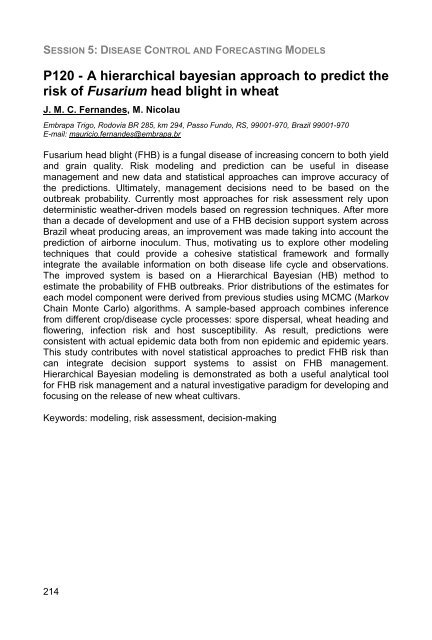EFS12- Book of abstracts - Contact
EFS12- Book of abstracts - Contact
EFS12- Book of abstracts - Contact
Create successful ePaper yourself
Turn your PDF publications into a flip-book with our unique Google optimized e-Paper software.
SESSION 5: DISEASE CONTROL AND FORECASTING MODELS<br />
P120 - A hierarchical bayesian approach to predict the<br />
risk <strong>of</strong> Fusarium head blight in wheat<br />
J. M. C. Fernandes, M. Nicolau<br />
Embrapa Trigo, Rodovia BR 285, km 294, Passo Fundo, RS, 99001-970, Brazil 99001-970<br />
E-mail: mauricio.fernandes@embrapa.br<br />
Fusarium head blight (FHB) is a fungal disease <strong>of</strong> increasing concern to both yield<br />
and grain quality. Risk modeling and prediction can be useful in disease<br />
management and new data and statistical approaches can improve accuracy <strong>of</strong><br />
the predictions. Ultimately, management decisions need to be based on the<br />
outbreak probability. Currently most approaches for risk assessment rely upon<br />
deterministic weather-driven models based on regression techniques. After more<br />
than a decade <strong>of</strong> development and use <strong>of</strong> a FHB decision support system across<br />
Brazil wheat producing areas, an improvement was made taking into account the<br />
prediction <strong>of</strong> airborne inoculum. Thus, motivating us to explore other modeling<br />
techniques that could provide a cohesive statistical framework and formally<br />
integrate the available information on both disease life cycle and observations.<br />
The improved system is based on a Hierarchical Bayesian (HB) method to<br />
estimate the probability <strong>of</strong> FHB outbreaks. Prior distributions <strong>of</strong> the estimates for<br />
each model component were derived from previous studies using MCMC (Markov<br />
Chain Monte Carlo) algorithms. A sample-based approach combines inference<br />
from different crop/disease cycle processes: spore dispersal, wheat heading and<br />
flowering, infection risk and host susceptibility. As result, predictions were<br />
consistent with actual epidemic data both from non epidemic and epidemic years.<br />
This study contributes with novel statistical approaches to predict FHB risk than<br />
can integrate decision support systems to assist on FHB management.<br />
Hierarchical Bayesian modeling is demonstrated as both a useful analytical tool<br />
for FHB risk management and a natural investigative paradigm for developing and<br />
focusing on the release <strong>of</strong> new wheat cultivars.<br />
Keywords: modeling, risk assessment, decision-making<br />
214
















![Présentation CRB-anim [Mode de compatibilité] - Inra](https://img.yumpu.com/17418636/1/190x135/presentation-crb-anim-mode-de-compatibilite-inra.jpg?quality=85)